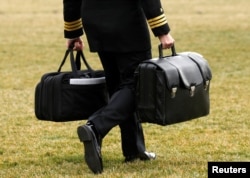President Donald Trump's administration could pursue development of new nuclear weaponry and explicitly leave open the possibility of nuclear retaliation for major non-nuclear attacks, if a leaked draft policy document becomes reality.
The Pentagon did not comment on the document, which was published by the Huffington Post website and prompted sharp criticism from arms control experts, who voiced concerns it could raise the risks of nuclear war.
The Defense Department said on Friday it did not discuss "pre-decision, draft copies of strategies and reviews."
"The Nuclear Posture Review has not been completed and will ultimately be reviewed and approved by the President and the Secretary of Defense," the Pentagon said in a statement.
One source familiar with the document told Reuters the draft was authentic, but did not say whether it was the same version that will be presented to Trump for approval.
The Republican Trump's predecessor, Democrat Barack Obama, declared his intent to reduce the role of nuclear weapons in his Nuclear Posture Review in 2010, the last time the policy document was crafted.
The Trump administration's draft document, said, however, that Obama-era assumptions of a world where nuclear weapons were less relevant proved incorrect.
"The world is more dangerous, not less," it said. It more readily embraces the role of nuclear weapons as a deterrent to adversaries, and, as expected, backs a costly modernization of the aging U.S. nuclear arsenal.
The Congressional Budget Office has estimated that modernizing and maintaining the U.S. nuclear arsenal over the next 30 years will cost more than $1.2 trillion.
The document sought to put those costs in perspective, noting that maintenance of the existing stockpile would account for nearly half the projected costs. An effective nuclear deterrent was also less expensive than war, it said.
New weapons
The draft document noted that Russia and China were modernizing their nuclear arsenals, while North Korea's nuclear provocations "threaten regional and global peace."
The draft document said the United States, while honoring all treaty commitments, would pursue development of a new nuclear-armed sea-launched cruise missile. It would also modify a small number of existing submarine-launched ballistic missile, or SLBM, warheads to provide a nuclear option with a lower payload.
In what arms control experts said appeared to be a nod to the threat of a devastating cyberattack, perhaps one that could knock down the U.S. power grid, the document also left open the possibility of nuclear retaliation in "extreme circumstances."
"Extreme circumstances could include significant non-nuclear strategic attacks," it said.
Kingston Reif, director for disarmament research at the Arms Control Association advocacy group, said the draft document was a departure from long-standing U.S. policy.
"It expands the scenarios under which the United States might use nuclear weapons and therefore increases the risk of nuclear weapons use," Rief said.
Although it reaffirmed an Obama-era pledge not to use or threaten to use nuclear weapons against non-nuclear weapons states if they joined and adhered to the nuclear Non-Proliferation Treaty, the draft introduced a caveat. The United States reserved the right to alter that assurance, given the evolving threat from non-nuclear technologies.
Michaela Dodge, senior policy analyst at the Heritage Foundation, said the draft document appeared to be intentionally ambiguous about when and how the United States might retaliate, to better deter adversaries.
"If we are explicit about saying [when] we will not retaliate with the strongest weapons we have, we are implicitly telling our adversaries you can plan for these scenarios more freely," Dodge said.







